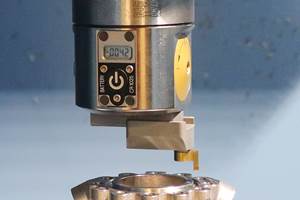One Insert For More Operations
Conventional wisdom about standard milling operations has always been that compared to square shoulder cutters, lead angle cutters are easier on the spindle, can be run at higher table feed rates, and cut freer. Finishes are typically better and, with the addition of a wiper flat insert, finishes could be further improved. Due to the chip thinning attributes of this type of cutter, actual table feeds can be more rapid, albeit at the sacrifice of some depth of cut compared to a zero lead cutter.
Conventional wisdom about standard milling operations has always been that compared to square shoulder cutters, lead angle cutters are easier on the spindle, can be run at higher table feed rates, and cut freer. Finishes are typically better and, with the addition of a wiper flat insert, finishes could be further improved.
Due to the chip thinning attributes of this type of cutter, actual table feeds can be more rapid, albeit at the sacrifice of some depth of cut compared to a zero lead cutter.
The force on the cutter body is determined by the point of application (cut line extension from the spindle), its direction (feed and edge inclination) and magnitude (feed rate and depth of cut). The vector quantity, or combined forces, of a lead angle cutter is directed more toward the spindle in a radial rather than axial direction, hence the viewpoint that the lead angle cutter is easier on the spindle.
Finishes are primarily determined by the feed rate per tooth and what type of corner or flat is in contact with the surface being cut. Square shoulder cutters have had somewhat of a disadvantage in the past.
As a result of these factors, most machine shops, by necessity, purchase lead angle cutters for general milling applications and square shoulder cutters for applications where a 90-degree corner is needed. In many cases, two milling operations are conducted. The first uses the lead angle cutter for rough and finish operations, which are followed by a square shoulder cutter to clean up any corners as needed.
The thought has always been that the versatility of a square shoulder insert would be nice if it weren't for the drawbacks. These include higher cutting forces, fewer cutting edges, and usually a lower finish quality capability. Square shoulder cutters are generally relegated to specific needs.
Of course, lead angle cutters have drawbacks as well. The obvious lack of versatility with a lead angle cutter is one, as is the inherently smaller depth of cuts. From a shop's perspective, the need for both types of cutters requires a larger tool crib inventory.
This begs the question, what if a square shoulder cutter was designed to reduce cutting forces, had the strength to take higher feed rates, could be free cutting enough to allow for large depths of cut and could create excellent surface finishes?
Mitsubishi Materials says it has developed such a cutter. The company calls it the BSX. The new cutter exhibits the free cutting characteristics of a pure positive rake cutter while having excellent chip evacuation. Cutting forces are reduced significantly with this new design, and insert strength is similar to that normally associated with pure negative rake cutters. Surface finishes are "exceptional," says the company.
The BSX cutter uses a square shoulder with a complex chipbreaker system that reduces cutting forces. A unique pocket design on the cutter body features an anti-expulsion system. Essentially this design adds safety to high rpm running, as the insert relies on its seat rather than the clamp screw for retention. The seat has a round protrusion with the clamp screw hole as its center. A mating recess is pressed into the insert that envelopes the protrusion as the insert is clamped down—trapping it in place.
In almost every shop doing metalworking, the need to increase throughput is a battle cry. Of the various ways to accomplish this task one of the most promising, as far as significant impact, is the ability to get more process range from a given cutter. Multiple operation inserts such as Mitsubishi's BSX are among the offerings that will help shops achieve their throughput goals.
Should you toss out your lead angle tools? No, of course not. The principles of milling haven't changed, only some of the process alternatives available to the metalworking shop.
Related Content
Choosing Your Carbide Grade: A Guide
Without an international standard for designating carbide grades or application ranges, users must rely on relative judgments and background knowledge for success.
Read MoreGrooving Attachment Streamlines Operation by 75%
A grooving attachment enabled Keselowski Advanced Manufacturing to reduce cycle times by over 45 minutes on a high-value, high-nickel part feature.
Read MoreWidia Introduces Solid End Mill for Shoulder and Side Milling
The WCE solid end milling series features a five-flute geometry specifically designed for optimal performance when shoulder milling and side milling carbon, stainless steel and cast iron.
Read MoreA New Milling 101: Milling Forces and Formulas
The forces involved in the milling process can be quantified, thus allowing mathematical tools to predict and control these forces. Formulas for calculating these forces accurately make it possible to optimize the quality of milling operations.
Read MoreRead Next
3 Mistakes That Cause CNC Programs to Fail
Despite enhancements to manufacturing technology, there are still issues today that can cause programs to fail. These failures can cause lost time, scrapped parts, damaged machines and even injured operators.
Read MoreThe Cut Scene: The Finer Details of Large-Format Machining
Small details and features can have an outsized impact on large parts, such as Barbco’s collapsible utility drill head.
Read More













.png;maxWidth=300;quality=90)











